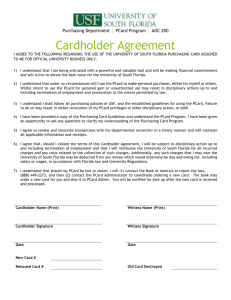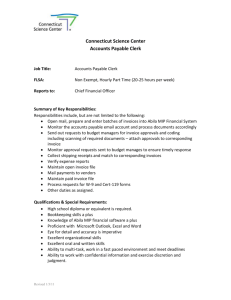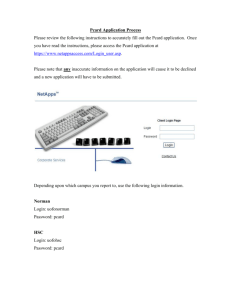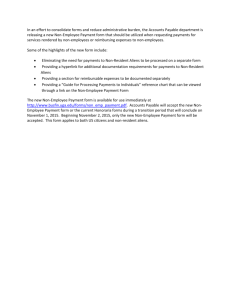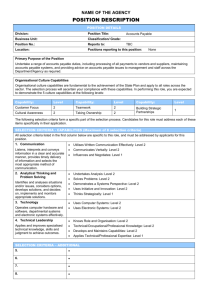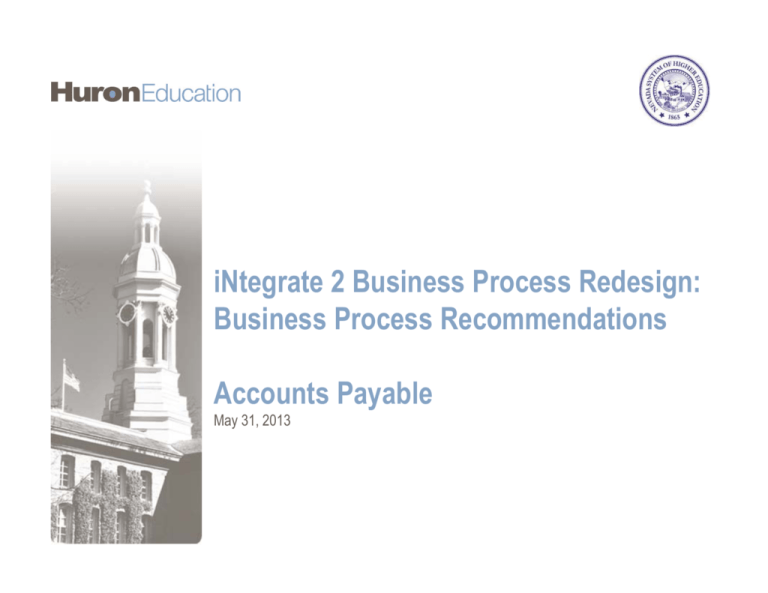
iNtegrate 2 Business Process Redesign:
Business Process Recommendations
Accounts Payable
May 31, 2013
Business Process
Recommendations: Introduction
Business Process Recommendations
SUB-PROCESS RECOMMENDATION CONTENTS
Recommendations for a redesigned workflow and supporting materials for each of the sub-processes reviewed as part
of the iNtegrate 2 BPR project are detailed in the following section. Each sub-process section includes the following:
•
Process Overview: A summary narrative of key process steps within the sub-process.
•
Recommended Future State Process Flow: Detailed process flow of the Future State process steps.
•
Key Process Changes: For those steps within the Future States that represent primary changes (for one or more
NSHE institutions), an explanation, and justification as necessary, for the process change is highlighted
•
Alternative Process Options: Process Options not recommended in the future state flow are highlighted along
with a justification of why this option is NOT recommended or incorporated in the process.
•
Policy Change Requirements: Instances when either institutional or NSHE policy need to be developed or revised
in order to facilitate the recommended process are noted, including recommendations for policy content.
•
Implementation Challenges: When elements of the recommended future state process were questioned during
workshops or noted as significant areas where implementation would be difficult, further discussion and justification
is provided along with examples of institutions also utilizing the recommended process.
•
The examples provided are individual institutions utilizing these recommended practices. NSHE represents a
diverse set of 8 institutions and the system office presenting limitations in identifying a comparable system or
organization that has broadly implemented “best practice” or recommended processes.
•
Technology Requirements: Elements of a required technology to enable the process are listed by process step.
•
Reporting Requirements: Reports, metrics and data points required to monitor and control the process are listed.
•
NSHE Feedback: Index of comments/feedback provided by NSHE institutions and the Huron response, as needed.
© 2012 Huron Consulting Group. All Rights Reserved. Proprietary & Confidential.
Draft & Confidential, Not for Distribution.
3
Business Process Recommendations
POINTS TO CONSIDER
Each sub-process section incorporates some fundamental concepts that should be understood in order to fully
consider the recommendations and supporting content.
•
•
Recommendations versus Current State:
•
These process recommendations represent Huron’s recommendations for a future state business process
and are not intended to comment on the current state processes across NSHE.
•
Some process elements may already be the practice of some or all NSHE institutions.
Business Process Swimlanes (horizontal bands):
•
The business process focuses on the process steps and the work accomplished in these steps and not
the process owners/work locations. Therefore, the developed flows include general swim-lanes that are
not role/location specific, such as Accounts Payable Administration, Travel Administration, Research
Administration, etc.
•
Flows do include required roles like Vendor, faculty/employee/Investigator, etc. but they do not highlight
Administrative Assistant, Vice President of X, etc. The recommended process steps can be applied
universally and the steps can be aligned in whatever roles/units are appropriate by institution.
© 2012 Huron Consulting Group. All Rights Reserved. Proprietary & Confidential.
Draft & Confidential, Not for Distribution.
4
Business Process Recommendations
POINTS TO CONSIDER
Each sub-process section incorporates some fundamental concepts that should be understood in order to fully
consider the recommendations and supporting content.
•
Existing Supplemental Systems:
•
•
Some NSHE institutions have implemented different “systems” or technologies that are supplemental to
the Human Resources or Finance Administration Systems. These process flows assume the existing
technologies are integrated into the Future State Business Process.
Out of Scope Systems:
•
Some process flows incorporate Non-Human Resource/Finance Systems that are out of scope for
iNtegrate 2 (i.e. a Pre-Award “tracking system”). However, in order to be in line with best practice
elements, these out-of-scope technologies were incorporated into the recommended processes.
© 2012 Huron Consulting Group. All Rights Reserved. Proprietary & Confidential.
Draft & Confidential, Not for Distribution.
5
Business Process
Recommendations: Accounts
Payable
Accounts Payable BPR: PO/Non-PO Payments
PROCESS OVERVIEW
The PO/Non-PO Payments represents the sub-processes in which suppliers are paid for services and goods
provided, either through the Purchase Order or Non-Purchase Order process.
• Non-PO Payments:
• Institutions initiate the vouchering process by submitting an electronic form requesting payment and
including supporting documentation.
• The exception request is reviewed and approved within the department/organization.
• Accounts payable receives and reviews the exception request.
• The voucher is initiated.
• Supplier remittance information is validated.
• The voucher is finalized and payment issued.
•
PO Payments:
• A supplier issues an invoice.
• The invoice is received by the institution and sent to the finance/payables department for processing.
• The invoice is imaged, matched to the order/receipt.
• A voucher is initiated.
• Supplier remittance information is validated.
• The voucher is finalized and payment issued.
Draft & Confidential, Not for Distribution.
7
Department
Start
Accounts Payable: Non-PO Related Payments, Page 1
1: Dept. Identifies
Need to Remit
Payment for Non-PO
Related Expenses
(ISP, PV, etc.)
2: Access Forms And
Selects Appropriate
Payment Type and
Mechanism (e.g.,
Wire)
3: Populate Form
with Required
Information (Invoice
Number, Amount,
Service Dates, etc.)
4: Attach Required
Documentation and
Submit Form into
Workflow
Yes
A
No
Reinitiate
Process
A
6: Form Routed to
Accounts Payable
for Processing
7: Form Routed for
Finance Office
Review
8: Approved?
Yes
Process
Form
No
Institution
5: Internal
Approval
Required?
10: Can Request
be Modified?
Yes
11: Update and
Approve Form
No
12: Reject Request
13: Requester
Notified of Rejection
End of Process
Process
Form
Accounts Payable: Non-PO Related Payments, Page 2
Process
Form
14: Non-PO Related
Payment Received
in AP Processing
Queue
16: Valid
Request?
15: Review Request
Yes
17: Finalize Form
and Generate
Voucher
18: Review Voucher
A
No
20: Direct Requester
to Resubmit Request
Using Appropriate
Channel (e.g., PO
Related Invoice)
Accounts Payable
19: Notify Requestor
of Violation of
Process
A
21: Validate Payee
Configuration
22: OK to Pay?
Yes
22.1: Wire
Payment?
Yes
22.2: Confirm
Availability of Funds
and Coordinate Wire
Transfer
No
24: Adjust Payment
as Required
No
Reinitiate
Process
23: Approve
Voucher
End of Process
Accounts Payable: PO Related Payments, Page 1
Supplier
1: Can an
eInvoice be
Provided?
Yes
2: Generate
Electronic Invoice
and Route to NSHE
ERP
Three
Way
Match
No
3: Generate Paper
Invoice and Mail to
Bill to Address
Specified on the
Purchase Order
Accounts Payable – Invoice Intake
4: Payment Related
Document Received
by Invoice Intake
and Time Stamped
5: PO
Displayed on the
Invoice?
Image
Invoice
Yes
No
Yes
7: Intake Staff
Investigates Invoice
to Determine PO
8: Related PO
Identified?
No
9: Contact Supplier
to Identify Invoice
Owner
10: Invoice
Owner
Identified?
No
End of Proecess
Yes
11: Update Invoice
to Reflect PO
Number
Accounts Payable
Accounts Payable
– Invoice Intake
Accounts Payable: PO Related Payments, Page 2
Image
Invoice
15: Build Voucher
Based on PO Lines
Invoices
13: Index the Invoice
to the Underlying
Purchase Order
14: Route the
Invoice for
Vouchering
16: Populate
Voucher Header
(e.g., Invoice
Number, Invoice
Date)
17: Update Voucher
Lines (if required) to
Reflect Invoice
Quantities /
Amounts
18: Validate Voucher
19: Ready to
Submit?
No
21: Update Voucher
as Required
22: Execute 3 Way
Match
Matching Process
12: Image Invoice
Document
Three
Way
Match
23: Exceptions
Generated?
Yes
24: Route
Exceptions for
Review
Yes
26X: Route Voucher
for Review
Match
Exception
No
25: Additional
Ad-Hoc Reviews
Required?
No
27: Voucher
Finalized and
Scheduled for
Payment
End of Process
Voucher
Review
Yes
20: Finalize Voucher
Accounts Payable: PO Related Payments, Page 3
Yes
Match
Exception
28: Receive
Notification of
Match Exception
29: Reconcile Match
Exception
30: Additional
Exceptions to
Reconcile?
No
Exception Handler
31: Voucher is Saved
Voucher
Review
32: Perform Review
Voucher Review
33: Approved?
31: Voucher is Saved
34: Work with
Accounts Payable to
Address Underlying
Issues
Three
Way
Match
Three
Way
Match
35: Approve
Voucher
End of Process
Accounts Payable BPR: PO/Non-PO Payments
KEY PROCESS CHANGES
The following table outlines the major process changes (NSHE-wide) incorporated into the recommended process.
Process
Flow Title:
Non-PO Related
Payments
Non-PO Related
Payments
Non-PO Related
Payments
PO Related Payments
Process
Step(s):
Explanation and Change Justification:
2
Users access a list of forms and select the appropriate one for their current need.
5
With the use of online forms, payment requests are routed electronically for review and approval.
14
14
With the utilization of electronic forms, AP Departments are no longer be forced to manually track/log the receipt of non-PO
related payments.
An image is routed for vouchering, reducing the need to manually pass paper between Accounts Payable staff.
Draft & Confidential, Not for Distribution.
13
Accounts Payable BPR: PO/Non-PO Payments
IMPLEMENTATION CHALLENGES
Some recommended process changes may be particularly challenging during the implementation phases.
Implementation Challenge Area: Establishing Encumbrances
• Individuals within departments may utilize means other than the eProcurement system (excluding the PCard) to obtain goods, requiring either an
encumbrance to be established at the time of invoice receipt or a direct voucher to be processed. Either approach takes resource time, limits visibility of
open commitments, and decreases NSHE institution’s leverage with suppliers.
• However, as a part of moving to an eProcurement system, the number of direct payment vouchers processed should decrease given that users should
be more easily able to generate a purchase order for goods and services.
• While there will still be valid reasons to process payments based on the invoice alone, institutions should consider requiring “after the fact” payment
requests for goods or services that should have been reflected on a purchase order to be routed for additional reviews prior to payment in order to create
a disincentive to paying upon invoice receipt.
• In the non-system cases, individuals will be required to establish encumbrances prior to obtaining the goods or services, and implementing this change in
behavior could be a challenge and will require clear training and communication on the requirements.
Recommended Process References
Institution:
Southwestern Public
University
Northeastern Research
University
Current Process:
Requires payment request for goods or services suited for requisitions (e.g., scientific supplies) to be routed for additional review and approval
prior to payment being made.
Analyses payment activity to identify “after the fact” transactions. Works with department heads to understand the factors behind the lack of
compliance with the policy and assigns resources to support greater compliance within the organization.
Draft & Confidential, Not for Distribution.
14
Accounts Payable BPR: PO/Non-PO Payments
TECHNOLOGY REQUIREMENTS
The following table lists the system technology requirements necessary to support the recommended process.
Process
Flow Title:
Non-PO Related
Payments
Non-PO Related
Payments
Non-PO Related
Payments
Non-PO Related
Payments
Process
Step(s):
Technology Requirement:
2
Provide users access to a listing of electronic forms that can be utilized to initiate payments for non-PO related invoices.
4
Allow for end users to either attach documents to forms or link them to images stored in an enterprise imaging system.
5
Determine what, if any, institutional approvals are required based on the operator submitting the request and request attributes
and route it accordingly.
17
Transition information captured on forms to a voucher to reduce data entry demands on accounts payable team.
PO Related Payments
1
PO Related Payments
15
PO Related Payments
22
PO Related Payments
22.2
Utilize electronic invoices (where possible), especially for suppliers of high volume consumables (e.g., office supplies, research
supplies).
Automatically “flip” a purchase order into a voucher to reduce data entry demands on accounts payable team.
Automatically create vouchers for supplier provided eInvoices. Automatically load these vouchers into the system and apply the
same matching rules as paper invoices.
Provide a mechanism to manually check available funds balances within the ERP prior to finalizing a transaction (e.g., wire
transfers).
Draft & Confidential, Not for Distribution.
15
Accounts Payable BPR: PO/Non-PO Payments
REPORTING REQUIREMENTS
The following table lists the reporting requirements and data points that must be captured to support the
recommended process.
Process
Flow Title:
Reporting Requirement:
PO/Non-PO Related
Payment cycle time
Payments
PO/Non-PO Related
Matching exceptions
Payments
PO/Non-PO Related
Batch validation
Payments
Data Points/Metrics:
•
•
•
•
•
•
•
•
•
•
•
•
•
•
•
•
•
•
•
•
Invoice receipt date
Voucher create date
Payment scheduling date
Payment date
Elapsed time
Payables operator
Invoice source (e.g., paper, electronic)
Payment terms availability
Payment terms obtained
Supplier invoice number
Voucher number
Voucher create date
Matching exception
Payables operator
Supplier invoice number
Voucher number
Purchase order number (if applicable)
Remit to address
Payment amount
Payables operator
Draft & Confidential, Not for Distribution.
16
Accounts Payable BPR: PCard Issuance & Use
Usage
PROCESS OVERVIEW
PCard issuance and usage represents the sub-process in which NSHE-based individuals obtain and use NSHEissued Procurement Cards to purchase goods/services.
•
Employees request a PCard via an application form.
•
Department/organization personnel review and approve the application.
•
The PCard is officially requested from the issuing bank.
•
PCard requestor completes required training program (may occur concurrently with the card request).
•
PCard delivery is acknowledged by the recipient.
•
The PCard is used to obtain goods or services and supporting documentation is retained.
•
Charges are incurred.
•
A statement of account is generated.
•
PCard charges are reconciled and funding sources applied.
•
Audits of charges are conducted.
Draft & Confidential, Not for Distribution.
17
Financial Services / PCard
Department
Department/Requester
PCard: Issuance, Page 1
Start
1: Employee
Completes PCard
Application Form
and Selects Default
Code (Optional)
2: Obtain
Department Chair or
Director Level
Approval
4: Approved?
Yes
No
6: Review
Application
7: Approved?
Yes
A
5: Work with
Requester to Revise
Application
8: Assign Default
Account Codes and
Route for Approval
by Senior
Administrator
9: Approved?
No
12: Work with
Requester to Revise
Application
A
A
Yes
10: Initiate Request
with PCard Provider
11: Card Issued
by Provider?
No
No
13: Work with PCard
Administrator to
Resolve Issue(s)
14: Work with PCard
Provider to Resolve
Issue(s)
Yes
Receive
Card
Card Requester
Financial Services /
PCard Department
PCard: Issuance, Page 2
Receive
Card
15: Card Received by
Institution
16: Card Number
Logged Associated
to Requestor in
Tracking Database
17: Notify Requestor
Card is Available
18: Requester
Completes PCard
Training Program
19: Requestor
Obtains Card from
Financial Services /
PCard Department
End of Process
Department/Requester
PCard: Usage/Reconciliation
Start Process
1: Need for Goods
or Services
Identified
2: Goods Obtained
from Supplier and
Settled via PCard
6: User (Or
Designee) Accesses
PCard Approval
Form in ERP
7: Form is
Populated,
Documentation
Attached, and
Submitted
8: Approved?
3: Supplier Provides
User/Department
with Invoice /
Packing Slip
Yes
12: Form Routed to
Financial Services /
PCard Department
No
Financial Services / PCard
Department
9: Work with
Reviewer to Resolve
13: Audit of
Receipts, Supporting
Documentation, and
Appropriateness of
Purchase Performed
14: Approved?
No
15: Work with
Department to
Obtain Required
Documentation
Yes
16: Form Approved
End of Process
4: Statement of
Account is
Generated
5: Statement of
Account is
Reconciled and
Funding Assigned
Accounts Payable BPR: PCard Issuance & Usage
KEY PROCESS CHANGES
The following table outlines the major process changes (NSHE-wide) incorporated into the recommended process.
Process
Flow Title:
Process
Step(s):
PCard Usage
7
Explanation and Change Justification:
With the further utilization of imaging equipment for procurement and payables processes, the scanning of the original
supporting documentation is performed by the department or academic unit rather than the PCard Administration unit.
Draft & Confidential, Not for Distribution.
21
Accounts Payable BPR: PCard Issuance & Usage
ALTERNATIVE PROCESS OPTIONS
The following table outlines the alternative process options that are not recommended for implementation.
Process
Step(s):
Alternative Process
Justification for Non-Recommendation:
Given the low PCard application rejection rates cited by NSHE institutions, it
was not recommended that training be required prior to the card application
being routed to the bank.
PCard Issuance
18
Require PCard applicants to complete training prior to requesting the
card from the issuing bank.
Rather, on-demand training should be made available to requestors to allow
them to complete the required courses at some point prior to physically
obtaining the card.
This allows the request for a card to be expedited to the bank. Therefore, this
card is now available for use as soon as it is received by the institutions and
the individual has completed training. Therefore, the bottleneck is shifted to
the individuals requesting the card and away from the bank.
Draft & Confidential, Not for Distribution.
22
Accounts Payable BPR: PCard Issuance & Usage
POLICY CHANGE REQUIREMENTS
The following table outlines the policy change requirements necessary to facilitate the recommended process.
Policy Level:
Policy Requirement
Type:
Policy Development/Addition/Change Requirement:
NSHE institutions should develop policy outlining requirements for issuing and approving P-Cards.
Institution
Develop/Change
Typically, these required institutional approvals are based on reporting relationships, as opposed to fund
“ownership” driving approvals for procurement transactions. Reporting relationships can often be harder to
determine and maintain than funding ownership, but to the greatest extent possible, the policy should outline the
role/position responsible for approving P-Card issuance.
Draft & Confidential, Not for Distribution.
23
Accounts Payable BPR: PCard Issuance & Usage
IMPLEMENTATION CHALLENGES
Some recommended process changes may be particularly challenging during the implementation phases or were
highly contested and discussed during the workshops.
Implementation Challenge Area: Data acquisition for workflow
As with requisition approvals, NSHE institutions should consider how the approval chain should be reflected in the PCard issuance. Areas like PCard often
employ a reporting relationship for approvals where procurement transactions might be routed for approval based on ownership of the funding source being
charged. Reporting relationships can often be harder to determine and maintain than funding ownership.
Draft & Confidential, Not for Distribution.
24
Accounts Payable BPR: PCard Issuance & Usage
TECHNOLOGY REQUIREMENTS
The following table lists the system technology requirements necessary to support the recommended process.
Process
Flow Title:
Process
Step(s):
PCard Issuance
PCard Usage
1
6
Technology Requirement:
Provide users access to a listing of electronic forms that can be utilized to initiate requests for things like PCard applications.
Allow PCard holders (or their designee) to submit their request for approval to their supervisor via an electronic form.
Draft & Confidential, Not for Distribution.
25
Accounts Payable BPR: PCard Issuance & Usage
REPORTING REQUIREMENTS
The following table lists the reporting requirements and data points that must be captured to support the
recommended process.
Process
Flow Title:
PCard Usage
PCard Issuance
Reporting Requirement:
PCard Spend / Reconciliation
Issued PCards
Data Points/Metrics:
•
•
•
•
•
•
•
•
•
•
•
•
•
•
•
•
•
Charge date
Merchant
Transaction amount
Transaction date
Item description (if available from provider)
Post date
Reconciliation date
Merchant diversity classification
Merchant classification code
Expense accounting codes
Departmental hierarchy data
Card holder
Cardholder hierarchy data (e.g., supervision, liaison info)
Card Issue date
Account standing
Cycle/month approval limits
Card level merchant classification code restrictions/approvals
Draft & Confidential, Not for Distribution.
26
Business Process
Recommendations: NSHE
Feedback
NSHE Feedback: Accounts Payable
ROUND 1: MARCH – APRIL 2013
The following table outlines the NSHE feedback and commentary, as well as Huron response when applicable.
SubProcess/
Institution
Topical
Area
PO/Non-PO
NSC
Payments
PO/Non-PO
NSC
Payments
PO/Non-PO
UNLV
Payments
PO/Non-PO
UNLV
Payments
PO/Non-PO
UNLV
Payments
Comments/Feedback
Huron Response
Will employees have to use the eProcurement system for reimbursements?
An eProcurement system can be used to initiate employee
reimbursements
How will the system check if sales tax is payable or not? Or determine if it’s a Sales tax exemption can be tracked at either the business unit
purchase for equipment?
level or at a transaction level depending on the requirements
of the institution. In regards to purchase of equipment, often
this is identified by the object (or account) code utilized on the
distribution line
Should emphasize that non-PO payments should be exception only.
The goal is to minimize the number of non-PO related
payments and the "Accounts Payable BPR: PO/Non-PO
Payments - Implementation Challenges" slide tries to
addresses the considerations for processing such payments.
Why is "Confirm Available Funds" only applicable if wire transfer is used? Also, This point generated quite a bit of discussion at the workshops
shouldn't this be done by Dept. before submitting request, and would a new and we ultimately came to the conclusion that there needs to
system be able to encumber the authorized non-PO payment items such as be a final manual check of funds availability prior to sending a
ISP contract, etc.?
wire (versus the inherent system checks that will occur when
the voucher is finalized). The Technology Requirements table
indicates the need to have the capability to manually validate
available funds prior to finalizing a transaction.
Shouldn't non-PO payments be exception only, even in the Future State?
Establishing an encumbrance prior to obtaining the goods or
services is the best practice. In addition, there are a set of
transactions that will likely result in a non-PO related invoice.
While you could argue that the institution could create the
encumbrance prior to processing the invoice, the materials
reflect the process of using a form (to capture the exceptions)
to generate the voucher.
Draft & Confidential, Not for Distribution.
28
NSHE Feedback: Accounts Payable
ROUND 1: MARCH – APRIL 2013
The following table outlines the NSHE feedback and commentary, as well as Huron response when applicable.
SubProcess/
Institution
Topical
Area
Comments/Feedback
Huron Response
Will the electronic forms mentioned be forms created by UNR staff or an
outside vendor?
PO/Non-PO
UNR
Payments
PO/Non-PO
UNR
Payments
PO/Non-PO
UNR
Payments
PO/Non-PO
UNR
Payments
This ultimately depends on the selected vendor and the
associated services contract, as well as what forms are
inherently available within the ERP. Since it is likely that you
will require custom forms, I would recommend you consider
requiring either your software or service provider to build a
number of forms for you in conjunction with NSHE/institution
technical teams to facilitate knowledge transfer.
Will the transition information also include information from the vendor’s
Yes, it would include the pieces of information included on the
invoices?
form.
Would a program need to be written for each vendor so that their electronic
Very good question. Again, this depends on the ERP selected
and the associated eProcurement module. Some
invoices could be read and processed by AP?
eProcurement providers include the development of
order/invoice interfaces as a part of their offering, others
require custom interfaces for each supplier. I can say that the
market seems to be moving in the direction of treating supplier
integration as a managed service, removing the client from
being directly involved in the development of custom
programs.
Can you explain in more detail the automatic “flip” of a PO into a voucher and A PO flip is used to transition header and line item information
how that works with 2-way and 3-way matching?
from a purchase order to an invoice, minimizing data entry
requirements and ensuring consistent product descriptions
between PO and invoice tables. If I understand your question
correctly, in its purest sense, “flipping” a PO into an invoice
shouldn’t impact the 2/3 way matching process. Rather, it
should simplify the processing of PO related invoices.
Draft & Confidential, Not for Distribution.
29
NSHE Feedback: Accounts Payable
ROUND 1: MARCH – APRIL 2013
The following table outlines the NSHE feedback and commentary, as well as Huron response when applicable.
SubProcess/
Institution
Topical
Area
Comments/Feedback
How does any supporting vendor invoices get attached to the Online forms?
PO/Non-PO
UNR
Payments
PCard
Issuance &
Usage
PCard
Issuance &
Usage
PCard
Issuance &
Usage
UNR
NSC
The P-card department currently scans the “finished” P-card statement and
supporting documents? What would be an estimate of the hardware cost
(Medium/high volume scanner) and labor cost to now scan all documents at
each department/academic unit and send them electronically to the P-card
department for audit? Would each department be responsible for ensuring
that the documents were correctly scanned? (ie two sided documents, Tape
over amount on the receipts are readable, etc.)
Why do we need a Statement of Accounts (which requires approval) and an
approval form?
Are you suggesting monthly audits of every card?
NSC
Huron Response
While many procurement systems will provide the capability to
attach documentation to a form in a fashion similar to
attaching documents to an email, an integrated document
management system will likely be implemented in conjunction
with the ERP that will make scanned images easily accessible
from online forms, vouchers, etc.
While I do not have hardware and labor estimates, you bring
up a good point related to document management capabilities
of your future ERP. Institutions will likely be expected to
participate in the document scanning process, which would
include confirming the scan completed successfully.
The statement of account and approval form will be utilized in
the reconciliation process
Where possible, it is recommended that an audit of the
supporting documentation be performed for all cards
Draft & Confidential, Not for Distribution.
30
NSHE Feedback: Accounts Payable
ROUND 1: MARCH – APRIL 2013
The following table outlines the NSHE feedback and commentary, as well as Huron response when applicable.
SubProcess/
Institution
Topical
Area
PCard
Issuance &
Usage
UNLV
PCard
Issuance &
Usage
UNLV
Comments/Feedback
Huron Response
This flow chart is done for the BCN approach - centralized. UNLV does not
The swim lane title has been updated to more clearly reflect
review all receipts in the accounting office. The receipts/statement of accounts the "swimlane-less" approach to our recommendations.
is decentralized and are the responsibility of the department heads who are Reconciliation can be completed either by a central
also responsible for reviewing the appropriateness of purchases. The Campus administrator or a departmental administrator, or another
Audit department conducts audits of cardholders. Campus Audit has a
administrator role not yet identified.
procedure they follow for determining the auditing of cardholders' files. They
work with the PCard coordinator in reviewing and addressing audit findings on
cardholders during the audits. If the recommendation is for centralized
approach there would need to be additional FTE requirements for UNLV to
consider.
We would have to review the PCard applications even if there is a low rate of Training should be required prior to the card being physically
rejections. The process of requesting the card from the bank has nothing to do turned over to the employee. Language has been clarified to
with training of the cardholder. All cardholders should have to go through
more clearly state that training should not be required prior to
some kind of training or at least pass a test that they understand the program the institution requesting the card from the bank, but rather
before they get the card issued to them from campus staff. We agree that on- requiring training prior to transferring ownership of the card to
demand training is the way to go but has nothing to do with getting the card
the requestor.
ordered from the bank and ready at the campus to issue to the cardholder
once they complete training/test whether the training/testing is on-line, ondemand, or in person. Training is necessary to make sure cardholders
understand what is/is not authorized and cardholder
responsibility/accountability.
Draft & Confidential, Not for Distribution.
31
NSHE Feedback: Accounts Receivable
ROUND 2: MAY 2013
The following table outlines the NSHE feedback and commentary, as well as Huron response when applicable.
SubProcess/
Institution
Topical
Area
PCard
Issuance &
Usage
UNLV
Comments/Feedback
This page needs to be revised to indicate the alternative process is to require
training before requesting card and not ‘requesting/obtaining’ card if your
recommendation is that training should not delay request for card from bank,
but should be required before card is turned over to recipient for use.
Huron Response
We have revised slide 13 and 18 clarifying the training is
required before using a card, but NOT before requesting a
card. In addition, the alternative option indicates that training
can be required prior to issuing a request.
Draft & Confidential, Not for Distribution.
32

